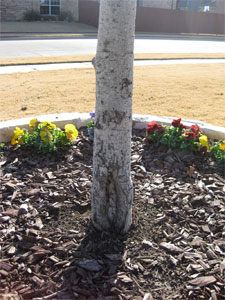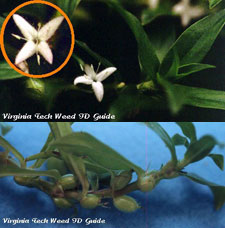Question and Answer – March 2009

Question: We have a red oak that is about six years old. Its growth has been very stunted for the past two years. I see this slit on the lower trunk that looks like disease, and in the summer the leaves are a pale light green and are curled. Any suggestions? D.W., Frisco.
Answer: This is sunscald, and it happened soon after the tree was planted. Red oaks in nature and in nurseries are shaded by adjacent trees. When we plant them into our landscapes, they’re usually out in the open. That’s why we always recommend using a paper tree wrap from the nursery to protect bare trunks of red oaks and Chinese pistachios against this type of damage. In fact, not only does the bark split like a chipped windshield on a cold, sunny day, but borers and decay can both set in. Leave the wrap in place for one to two years. By then, the tree’s leaf canopy should offer sufficient protection. However, this tree looks very weak and probably will need to be replaced. As for the light green leaves, that’s probably just a part of the same issue, although pin oaks resemble Shumard red oaks in overall appearance and leaf shape, and they suffer serious iron deficiency when we try to grow them in alkaline soils. Light green and even pale yellow leaves appear as the trees decline and die. However, it does not appear that that is your problem.

Question: I have a horrible problem with Virginia buttonweed. (I’ve attached a photo from the Virginia Tech Weed ID guide, since it’s dormant in my lawn right now.) What can I do to control it? Weedkillers don’t seem to work very well. P.T., no city given.
Answer: You do indeed have a tenacious weed. Online documents from various state universities suggest a combination product containing both trichlorpyr and chlopyralid. That mix is reported by research to be as much as three times more effective at controlling buttonweed than a standard 2,4-D broadleafed weedkiller spray. A farm supply store can help you, or a professional lawn care company could take care of the application for you.

Question: Do you know if the pomegranate variety ‘Sweet’ is adapted to North Texas? From the descriptions I’ve seen, the fruit is larger and much sweeter than those of ‘Wonderful.’ Advice? K.G., Frisco.
Answer: I have not seen the variety, but I did see several references to it online. Much of the best pomegranate research and production is in California. The U.C. Davis campus is renowned for its pomegranate program. I would suggest you do some Web searching for the wording pomegranate ‘Sweet’ to see what matches you find. I did find a retail source for it on the Web at Willis Nursery in Georgia: http://www.willisorchards.com/product/Sweet+Pomegranate+Tree.
I have never bought from this company, so I can’t vouch for them, but the online catalog looks good. The map associated with that variety’s web page suggests it should grow well for you. If you can find the variety here in Texas, that would always be better, but I’ve never seen it in nurseries.

Question: I spoke with you a few weeks ago on the radio about my Indian hawthorns. I have slowly lost one after another (four out of 14). It has happened on both sides of my driveway. The lab at Texas A&M looked at my root and branch samples and said it was "cultural." I spoke to another specialist on the phone and he suggested cotton root rot (my original thought). Can you tell from the photo? L.B., McKinney.
Answer: I’ve been around Indian hawthorns in Texas for the past 40 years, and I think the Plant Disease Diagnostic Laboratory hit it right on the head. This is not the way cotton root rot attacks Indian hawthorns (or any other plant). Cotton root rot is a soil-borne fungal disease that kills the plant entirely, not in sections. I have lost several plants, including Indian hawthorns, to it over the years, and it finishes them off very quickly during the hottest part of the summer. It also tends to move down a row, plant-by-plant. When the lab people said "cultural," they meant something in the care that the plants were given (or not given). I’ve seen hundreds of hawthorns that looked like this, and all of them got that way because they got too dry, if only for a day or two. This plant looks like it was very dry, almost to the point of completely dying. It appears that water was applied to it, but too late to save all of the branches. Had it been cotton root rot, the laboratory would have been able to pick that up in their cultures from the root samples you sent.

Question: I moved here from Colorado a little more than two years ago, and I can’t seem to make my lawn thrive. I have areas where the grass is better, but much of it looks like this. What can I do? R.S., Waco.
Answer: It’s hard to tell what might be wrong with your lawn from the photo of dormant turf, but it does look like it could be Take All Root Rot. It’s a serious fungal disease that has really risen to the top of the problems list for St. Augustine in the past decade. We have a great deal of information on it in our website, along with Texas A&M’s recommendations for controlling it.

